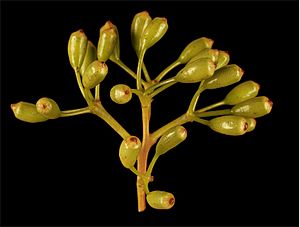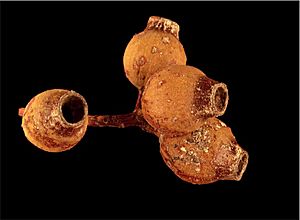Mountain marri facts for kids
Quick facts for kids Mountain marri |
|
|---|---|
 |
|
| Corymbia haematoxylon | |
| Scientific classification | |
| Genus: |
Corymbia
|
| Species: |
haematoxylon
|
| Synonyms | |
|
|
The Corymbia haematoxylon, also known as mountain marri, is a type of tree. It is found only in the south-west part of Western Australia. This tree has rough bark on its trunk and branches. Its adult leaves are shaped like a spear or a narrow egg. The flowers grow in groups of seven and are white. After flowering, it produces fruit shaped like an urn.
Contents
What the Mountain Marri Looks Like
The mountain marri tree can grow up to 15 meters (about 49 feet) tall. It has rough, brownish bark that looks like a puzzle on its trunk and branches. This tree also has a special woody swelling at its base called a lignotuber. This helps it regrow after a fire.
Young mountain marri plants have egg-shaped leaves. The adult leaves are arranged one after another along the stem. They are paler on the bottom side. These leaves are shaped like a spear or a narrow egg. They are usually 7 to 12 centimeters (about 3 to 5 inches) long. They are also 2 to 3.5 centimeters (about 0.8 to 1.4 inches) wide. Each leaf has a stalk, or petiole, that is 1.2 to 2.5 centimeters (about 0.5 to 1 inch) long.
The flower buds grow at the ends of the branches. They are on a main stalk called a peduncle, which is 1.2 to 2 centimeters (about 0.5 to 0.8 inches) long. Each part of this stalk has seven buds. These buds sit on smaller stalks called pedicels, which are 0.4 to 1.3 centimeters (about 0.2 to 0.5 inches) long.
When the buds are ready, they are oblong or oval shaped. They are 0.6 to 1.1 centimeters (about 0.2 to 0.4 inches) long. They are also 0.4 to 0.7 centimeters (about 0.3 inches) wide. Each bud has a flat cap called an operculum. The mountain marri flowers are white. They usually bloom from October or December to January or March. After the flowers, the tree produces a woody fruit. This fruit is shaped like an urn and is 1.5 to 3.6 centimeters (about 0.6 to 1.4 inches) long. It is also 1.2 to 2.7 centimeters (about 0.5 to 1.1 inches) wide. The seed compartments are hidden inside the fruit.
How the Mountain Marri Got Its Name
The mountain marri was first officially described in 1914. A scientist named Joseph Maiden gave it the name Eucalyptus haematoxylon. He wrote about it in a science journal. Later, in 1995, two other scientists, Ken Hill and Lawrie Johnson, changed its name. They renamed it Corymbia haematoxylon.
Where the Mountain Marri Lives
The Corymbia haematoxylon tree grows in open forests. You can find it on flat areas and slopes. It prefers sandy soil that is over sandstone or a type of rock called laterite. This tree grows in different groups in the western Darling Range. These areas are between Byford and Capel. There is also a separate group of these trees near Mount Lesueur. The mountain marri often grows near another tree called marri (Corymbia calophylla). It looks like a smaller version of that species.
See also
 In Spanish: Corymbia haematoxylon para niños
In Spanish: Corymbia haematoxylon para niños



